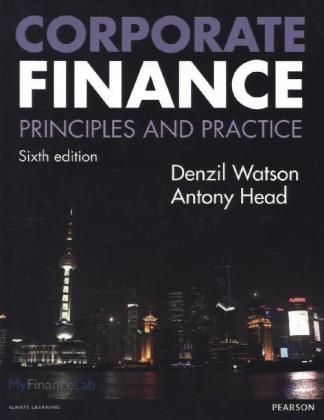
Corporate Finance
Pearson Education Limited (Verlag)
978-0-273-76274-4 (ISBN)
- Titel erscheint in neuer Auflage
- Artikel merken
Corporate Finance: Principles and Practice really does do what it says on the tin. Key principles and mathematical techniques using in finance are clearly explained step-by-step and later put into practice through the use of many vignettes taking a closer look at real well-known companies.
Provides a student-friendly approach to the key topics in corporate finance
Introduces appropriate tools and techniques for the financial manager
Vignettes featuring well-known companies to illustrate topics
Worked examples to consolidate learning points
Wide range of question material, both for practice and group discussion
This product is the book alone, and does NOT come with access to MyFinanceLab.
Preface
About the authors
Acknowledgements
Guided tour of the book
Guided tour of MyFinanceLab
1 The finance function
Learning objectives
Introduction
1.1 Two key concepts in corporate finance
1.2 The role of the financial manager
1.3 Corporate objectives
1.4 How is shareholder wealth maximised?
1.5 Agency theory
1.6 Corporate governance
1.7 Conclusion
Key points
Self-test questions
Questions for review
Questions for discussion
References
Recommended reading
2 Capital markets, market efficiency and ratio analysis
Learning objectives
Introduction
2.1 Sources of business finance
2.2 Capital markets
2.3 Capital market efficiency
2.4 Assessing financial performance
2.5 Conclusion
Key points
Self-test questions
Questions for review
Questions for discussion
References
Recommended reading
3 Short-term finance and the management of working capital
Learning objectives
Introduction
3.1 The objectives of working capital management
3.2 Working capital policies
3.3 Working capital and the cash conversion cycle
3.4 Overtrading
3.5 The management of inventory
3.6 The management of cash
3.7 The management of receivables
3.8 Conclusion
Key points
Self-test questions
Questions for review
Questions for discussion
References
Recommended reading
4Long-term finance: equity finance
Learning objectives
Introduction
4.1 Equity finance
4.2 The stock exchange
4.3 Rights issues
4.4 Scrip issues, share splits, scrip dividends and share repurchases
4.5 Preference shares
4.6 Conclusion
Key points
Self-test questions
Questions for review
Questions for discussion
References
Recommended reading
5 Long-term finance: debt finance, hybrid finance and leasing
Learning objectives
Introduction
5.1 Bonds, loan stock and debentures
5.2 Bank and institutional debt
5.3 International debt finance
5.4 Convertible bonds
5.5 Warrants
5.6 The valuation of fixed-interest bonds
5.7 The valuation of convertible bonds
5.8 Leasing
5.9 Evaluating the financial effect of financial choices
5.10 Conclusion
Key points
Self-test questions
Questions for review
Questions for discussion
References
Recommended reading
6 An overview of investment appraisal methods
Learning objectives
Introduction
6.1 The payback methods
6.2 The return on capital employed method
6.3 The net present value method
6.4 The internal rate of return method
6.5 A comparison of the NPV and IRR methods
6.6 The profitability index and capital rationing
6.7 The discounted payback method
6.8 Conclusion
Key points
Self-test questions
Questions for review
Questions for discussion
References
Recommended reading
7 Investment appraisal: applications and risk
Learning objectives
Introduction
7.1 Relevant project cash flows
7.2 Taxation and capital investment decisions
7.3 Inflation and capital investment decisions
7.4 Investment appraisal and risk
7.5 Appraisal of foreign direct investment
7.6 Empirical investigations of investment appraisal
7.7 Conclusion
Key points
Self-test questions
Questions for review
Questions for discussion
References
Recommended reading
8 Portfolio theory and the capital asset pricing model
Learning objectives
Introduction
8.1 The measurement of risk
8.2 The concept of diversification
8.3 Investor attitude to risk
8.4 Markowitz's portfolio theory
8.5 Introduction to the capital asset pricing model
8.6 Using the CAPM to value shares
8.7 Empirical tests of the CAPM
8.8 Conclusion
Key points
Self-test questions
Questions for review
Questions for discussion
References
Recommended reading
9 The cost of capital and capital structure
Learning objectives
Introduction
9.1 Calculating the cost of individual sources of finance
9.2 Calculation of weighed average cost of capital
9.3 Average and marginal cost of capital
9.4 The CAPM and investment appraisal
9.5 Practical problems with calculating WACC
9.6 WACC in the real world
9.7 The cost of capital for foreign direct investment
9.8 Gearing: its measurement and significance
9.9 The concept of an optimal capital structure
9.10 The traditional approach to capital structure
9.11 Miller and Modigliani (I): the net income approach
9.12 Miller and Modigliani (II): corporate tax
9.13 Market imperfections
9.14 Miller and personal taxation
9.15 Pecking order theory
9.16 Does an optimal capital structure exist? A conclusion
Key points
Self-test questions
Questions for review
Questions for discussion
References
Recommended reading
10 Dividend policy
Learning objectives
Introduction
10.1 Dividends: operational and practical issues
10.2 The effect of dividends on shareholder wealth
10.3 Dividend irrelevance
10.4 Dividend relevance
10.5 Dividend relevance or irrelevance?
10.6 Dividend policies
10.7 Alternatives to cash dividends
10.8 Empirical evidence on dividend policy
10.9 Conclusion
Key points
Self-test questions
Questions for review
Questions for discussion
References
Recommended reading
11 Mergers and takeovers
Learning objectives
Introduction
11.1 The terminology of mergers and takeovers
11.2 Justifications for acquisitions
11.3 Trends in takeover activity
11.4 Target company valuation
11.5 The financing of acquisitions
11.6 Strategic and tactical issues
11.7 Divestment
11.8 Private equity
11.9 Empirical research on acquisitions
11.10 Conclusion
Key points
Self-test questions
Questions for review
Questions for discussion
References
Recommended reading
12 Risk management
Learning objectives
Introduction
12.1 Interest and exchange rate risk
12.2 Internal risk management
12.3 External risk management
12.4 Future contracts
12.5 Options
12.6 Swaps
12.7 issues in interest and exchange risk management
12.8 Political risk
12.9 Conclusion
Key points
Self-test questions
Questions for review
Questions for discussion
References
Recommended reading
Answers to self-test questions
Glossary
Present value tables
Index
| Verlagsort | Harlow |
|---|---|
| Sprache | englisch |
| Maße | 193 x 248 mm |
| Gewicht | 844 g |
| Themenwelt | Wirtschaft ► Betriebswirtschaft / Management ► Finanzierung |
| ISBN-10 | 0-273-76274-5 / 0273762745 |
| ISBN-13 | 978-0-273-76274-4 / 9780273762744 |
| Zustand | Neuware |
| Haben Sie eine Frage zum Produkt? |
aus dem Bereich



